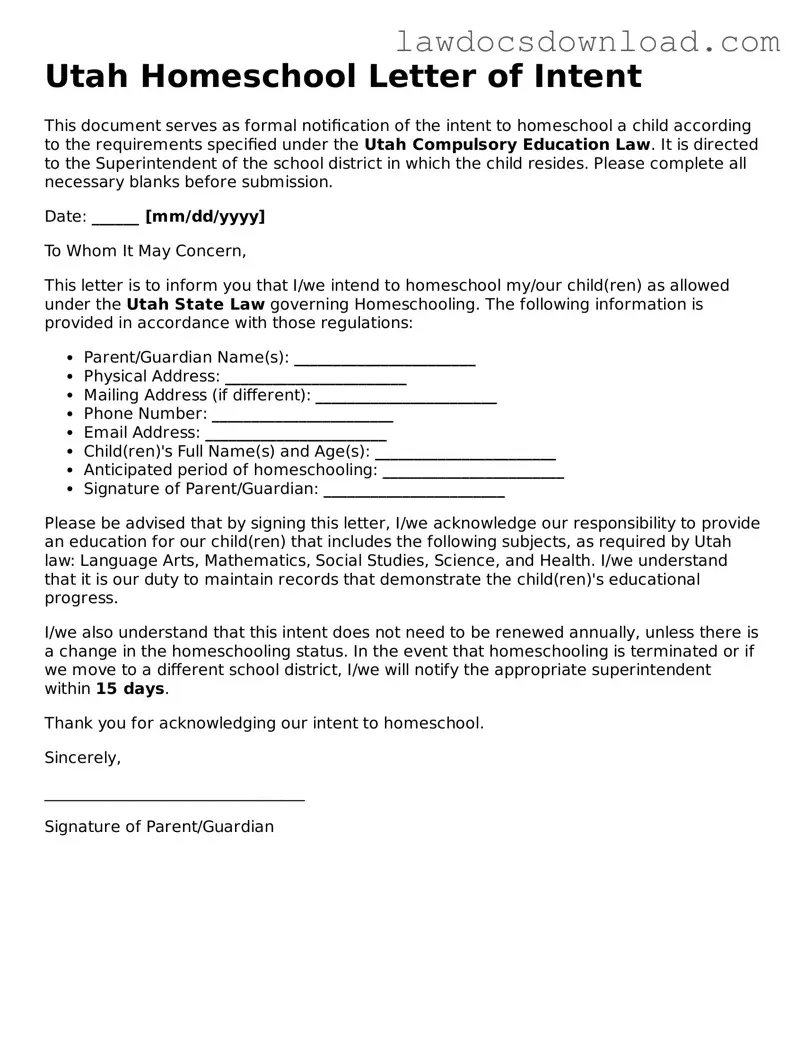Many parents undertaking the responsibility of homeschooling in Utah start by submitting a Letter of Intent to homeschool. However, several common errors can delay this process. Recognizing and avoiding these mistakes ensures a smoother path towards homeschooling.
First, a frequent oversight is not providing complete personal information. The form requires detailed contact information for both the parent or guardian and the student. Leaving sections incomplete can cause significant delays. It's crucial to double-check that all requested details, including addresses and phone numbers, are accurately filled in.
Second, often parents forget to specify the term of homeschooling. The Utah Homeschool Letter of Intent form needs clear indication whether the homeschooling is intended for a single year or more. This is essential as it informs the school district of the expected duration of the homeschooling period.
Third, signatures pose another common pitfall. Both the parent’s or guardian’s signature and the date are mandatory. Missing signatures or dating inaccurately can invalidate the form at once. Ensuring that these elements are correctly completed is vital.
Another error comes from misunderstanding the educational requirements. Utah law mandates certain subjects to be covered in homeschool curriculums. Parents sometimes fail to affirm that their homeschool will adhere to these requirements. It's necessary to acknowledge this commitment in the Letter of Intent.
Fifth, reluctance to submit the form in a timely manner also hinders the process. The Utah education system requires the Letter of Intent to be submitted before the homeschooling is set to begin. Delaying submission can complicate the student's status with their current school. Prompt submission is therefore advisable.
Sixth, using outdated forms can lead to denial. The state periodically updates the Letter of Intent form to reflect current legal and educational requirements. Always ensure you're using the most recent version available from the Utah State Board of Education's website.
Seventh, failing to keep a copy of the submitted form is a mistake. Having a record is crucial for any future references or to resolve any disputes that may arise. Once the form is filled and sent, maintaining a copy for personal records is a wise step.
Eighth, some parents mistakenly believe one form covers all children in the family. Each child being homeschooled requires a separate Letter of Intent. This misstep can easily disrupt the legal homeschooling process for multiple children.
Ninth, incorrectly listing previous or transferring schools sometimes occurs. For administrative purposes and records, it's important that the form correctly identifies any schools the child previously attended or is transferring from. This information assists in ensuring a smooth transition to homeschooling.
Tenth and finally, oversight in notifying the local school district if there are changes during the homeschooling period, including cessation, can create legal complications. It's crucial to communicate any significant changes to ensure compliance with state laws.
Avoiding these common errors when filling out Utah's Homeschool Letter of Intent form can significantly ease the transition into homeschooling and help maintain compliance with state requirements. It's all about attention to detail and adhering to the guidelines set forth by educational authorities.
